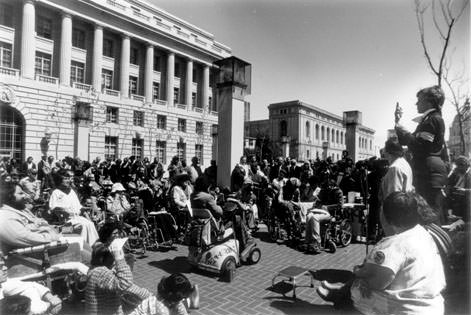
On April 5, 1977, a group of people with disabilities staged a sit-in protest in San Francisco to demand greater accessibility and accommodations for people with disabilities. This historic protest became known as the “504 Sit-in.” Although there were disability protests and Sit-ins across the country, San Francisco’s was the longest.
The protests were sparked by the government’s failure to implement Section 504 of the Rehabilitation Act of 1973 (Section 504), the first major disability rights legislation. Section 504 prohibited discrimination against people with disabilities in federal programs and activities receiving federal funding.
Want to subscribe to receive blog updates sign up today!
Despite Section 504 being signed into law by President Richard Nixon, Section 504 was not enforced for four years. This was in large part due to businesses and organizations lobbying against implementation, arguing that it was burdensome and unfair to expect them to implement accessibility or lose federal funding.
One of the 504 Sit-in participants Corbett Joan O’Toole shared, “At that time in history, there was simply no access—no right to an education, no public transit. You couldn’t get into a library or city hall, much less a courtroom.” Disabled people wanted to see the government committed to disability inclusion and access. The disabled activists warned that if Joseph A. Califano Jr., who served as the Secretary of Health, Education, and Welfare (HEW) during President Jimmy Carter’s administration, didn’t take action by April 4th, nationwide protests would ensue.
On April 4th, 1977, after the government did not sign the regulations into law, protests took place all over the country. In San Francisco, over 500 disabled individuals and their allies attended a rally on San Francisco’s Civic Center Plaza. Most of the protests happening across the country ended that day. But after the San Francisco rally, nearly 150 people with disabilities streamed into the HEW Federal Building and over 120 activists occupied the building, and refused to leave until their demands were met, even when threatened with arrest and eviction.
Government officials attempted to remove the activists from the building by cutting the phone lines and denying them food, water, medicine, and more. But the disabled protestors used sign language to communicate through the windows of the building to work with allied groups to get food, medicine, blankets, and more. Support came from a wide range of organizations and individuals, including labor unions, religious groups, civil rights activists, and the Black Panthers.
After two weeks of protesting, a group of Sit-in activists journeyed to Washington D.C. to intensify their efforts against Califano. They organized candlelight vigils outside of his residence and attempted to enter his office building by forcefully pushing their wheelchairs against the doors when their request for entry was denied. While in the capitol, Judy Heumann addressed congressional representatives and reporters:
“I can tell you that every time you raise issues of ‘separate but equal,’ the outrage of disabled individuals across this country is going to . . . be ignited. There will be more takeovers of buildings until finally maybe you begin to understand our position. We will no longer allow the government to oppress disabled individuals. We want the law enforced.”
After 28 days of the Sit-in and consistent pressure from the protestors, Califano finally signed Section 504 regulations. This protest also helped pave the way for the Americans with Disabilities Act of 1990 which expanded disability rights protections to the private sector and State and local governments.
As Kitty Cone shares, the Sit-ins were “the public birth of the disability rights movement. . . For the first time, disability really was looked at as an issue of civil rights rather than an issue of charity and rehabilitation at best, pity at worst.”
Today, the legacy of the 504 Sit-in lives on, as people with disabilities continue to fight for equal access and accommodations in all aspects of society. The protest was a powerful reminder of the importance of standing up for one’s rights and fighting for change, even in the face of adversity.
This post is a condensed version of a blog post by Maddie Crowley. “Disability History: The 1977 504 Sit-In,” https://disabilityrightsflorida.org/blog/entry/504-sit-in-history. It is republished with permission from the author and Disability Rights Florida.
